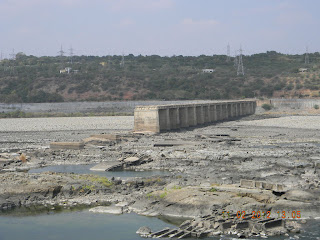Nagarjuna Sagar dam is the world's largest masonry dam built across River Krishna in Nalgonda district of Andhra Pradesh. A historical Buddhist town named Nagarjuna Konda, now an island, is located near Nagarjuna Sagar. The site is located 150kms south east of Hyderabad. Andhra Pradesh tourism arranges tours to Nagarjuna Sagar on weekends to cover sight seeing of the dam, museum at Nagarjuna Konda and Ethipothala falls located nearby.
I decided to take this trip on a saturday with my cousins and few friends. The tour costs Rs 500 per person only for the travel. Rs 120 is later collected later which includes payment for ferry service to reach Konda (Rs 90), entrance to the island and museum (Rs 10) and entrance to Ethipothala falls (Rs 10). The bus started at 7 30 am from Yatri Nivas in Secunderabad and took three and half hours to reach Nagarjuna Sagar.
We were dropped at AP tourism's restaurant on the left side of the dam for lunch. Meals was available for lunch (Rs 100).
We then boarded the bus which took us through the left side of the dam. The dam contains the Nagarjuna Sagar reservoir with a capacity of up to 11,472 cubic metres. The dam is 490ft tall and 1.6 km long with 26 gates which are 42ft wide and 45ft tall. The dam provides irrigation water to the districts of Nalgonda, Prakasam, Khammam and Guntur and electric power to the national grid.
The road over the dam is closed for vehicles and we had to do a detour across an alternate bridge constructed a few kilometres away from the dam.
We could see remains of an old bridge which seemed to have been broken due to reasons unknown.
We then crossed the canal on the south side of the dam from where water is diverted to the district of Nalgonda.
In about 20 mins, we reached the launch station from where ferries to Nagarjuna Konda start.
Some people were spending time on smaller boats (parisals) while we waited for the ferry.
The ferry had an upper and lower deck and could carry upto 300 passengers at a time. The trip to Nagarjuna Konda took 45 mins, a distance of 14 kms.
We could see rock structures on either side of the reservoir. The excavated remains of the Buddhist civilization have been reconstructed in the island.
Nagarjuna Konda is one of the richest Buddhist sites in India. It is named after Nagarjuna, a southern Indian master of Mahayana Buddhism who lived in 2nd century AD. The site was once the location of many Buddhist universities and monasteries, attracting students from as far as China, Gandhara, Bengal and Sri Lanka. The Buddhist archaeological sites there were submerged, and had to later be dug up and transferred to higher land on the hill, which had become an island.
We decided to check out the reconstructed monuments first. First, we saw a megalith - which is a cist burial representing the method of disposal of the dead in pre-christian era. It is marked on the ground by unworked boulders arranged in a circle.
One of the viharas is a Bodhisri Chaitya - originally this chamber formed part of Chuladharmagiri Vihara. The floor slabs registered the gifts by a lay disciple Upasika Bodhisri hailing from Goa. The other vihara is Chamatasri Chaitya Griha built by queen Chamatasri, sister of Vasishthi putra Chamtamula for the use of monks living in the adjoining Mahvina Seliya Vihara. There was also an old temple - its entrance only about 4ft in height.
The maha stupa lay a little farther in the island with flags representing Mahayana Buddhism adorning the areas around the stupa.
The most interesting monument was the Aswamedha. The founder of Ikshvaku dynasty performed the well known sacrifice of horse called Aswamedha. This ritual was one among the very elaborate sacrifice prescribed to be performed, only by a king of unquestionable authority and who had the recognition of his neighbouring kings as their over lord. The tank nearby was intended for the final purification bath and the structure in the shape of a tortoise (known as Kurmachiti) where part of the horse was sacrificed.
After visiting the monuments, we took a peak into the museum as well where ancient exhibits were arranged. Once done, we waited for the ferry which brought us back to the launch station.
From the launch station, the bus transported us to Ethipothala falls which was around 20 kms away. The falls over the mountains is visible from the park maintained by APTDC and a very inviting place to take profile photographs.
Children could play around in the park while we enjoy the beauty of the falls. The bus left from there directly back to Hyderabad - again a trip for three and a half hours. We were dropped at around 10 pm that capped off a pleasant trip and provided a peek into Buddhism of the past.























